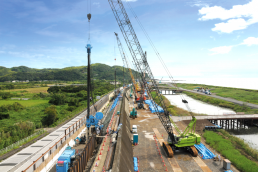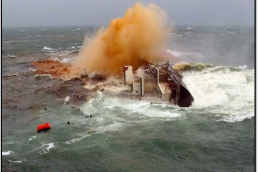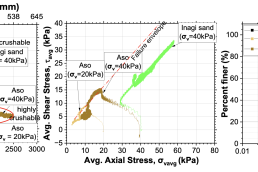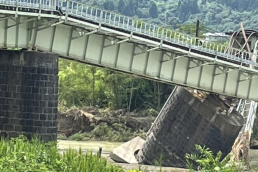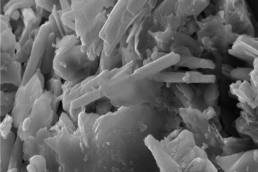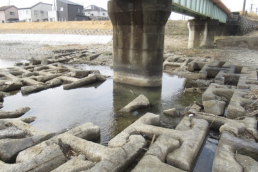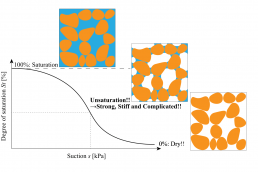Uncertainti
In general, subsurface investigations for design and construction of piles are conducted at several points that are distant from each other, around every 100 meters for example, and information between these investigation points are estimated by interpolation. On the other hand, spatial variation often exists in the real ground; geological structures may not be homogeneous in plan, and weak soils or hard cobbles may exist locally. This discrepancy between investigation results and real ground conditions significantly deteriorates the rationality of design and construction of piles.
一般に、杭/矢板の設計・施工計画に必要な地盤調査が実施される地点は離散的(たとえば100mおき)であり、これらの調査地点間の情報は内挿により推定される。他方、実際の地盤は、地層構造が水平方向に不均一であったり、強度の低い土や硬い転石が局所的に存在したりするなどして、空間的に不均一になっている場合が多い。調査結果と実際の地盤条件との差異が大きいと、杭/矢板の設計や施工の合理性が著しく損なわれる場合がある。
Press-in method / 圧入工法
Among plenty of piling techniques, Press-in Method is a relatively new technique that uses static jacking force to install piles, generating less noise and vibration. Its principle of gaining reaction force from previously installed piles allows press-in machines to stay and walk on top of the pile wall, and assures its spatial efficiency by removing temporary works. Coupled with auxiliary techniques such as augering or rotary cutting, it enables piles to penetrate through hard grounds or concretes; old revetments surrounded by other infrastructures can be renovated by pile walls without being removed in advance.
杭/矢板の施工法のうち、圧入工法は、静荷重を用いる低振動・低騒音の比較的新しい工法である。杭/矢板を地中に押し込むための反力を既設の杭/矢板から得る原理と、施工機械の自走機能により、施工空間を既設の杭/矢板上に集約し、仮設を大幅に削減する。オーガーや回転切削などの技術との組合せにより、硬質な地盤やコンクリートにも対応している。たとえば、他のインフラに囲まれた古い護岸を、事前に撤去することなく、鋼管杭を貫通させながら更新することができる。
Fig. 1
Fig. 2
Use of press-in piling data / 圧入データの利用
Another feature of Press-in Method is that it provides what we call press-in piling data; an automatic measurement system in a press-in machine offers penetration depth and jacking force for every pile during the piling work. This feature is expected to be helpful in improving the efficiency of design and construction of piles. So far, methods of estimating subsurface information such as SPT N and CPT qt are developed, and are supposed to serve as objective information for assuring the adequate termination of piling work or selecting additional auxiliary techniques when unexpected ground conditions are encountered. This research aims to extend the use of press-in piling data to estimating the performance of piles directly.
圧入工法の他の特徴として、圧入施工データの取得が可能であることが挙げられる。施工機械に備えられた自動計測システムにより、全ての杭/矢板について、圧入力や貫入深度などの情報を施工中に得ることができる。この特徴を利用することにより、杭/矢板の設計・施工を合理化できると期待される。これまでに、圧入施工データから標準貫入試験(SPT)のN値やコーン貫入試験(CPT)のqt 値を推定する方法を開発した。推定結果は、打止管理や想定外の地盤条件に遭遇した際の補助工法の再選定などにおいて客観的な情報として機能するものと想定している。本研究では、圧入施工データの利用範囲を拡大し、杭/矢板の性能を直接的に推定する方法を構築する。
Fig. 3
More Details...
1)Ishihara, Y., Okada, K., Yokotobi, T. and Kitamura, A., 2016. Pull-out resistance of a large diameter steel tubular pile installed by Rotary Cutting Press-in. Proceedings of the Third International Conference Geotec Hanoi 2016 – Geotechnics for Sustainable Infrastructure Development, pp. 141-147.
2)Ishihara, Y., Haigh, S. and Bolton, M. D., 2015. Estimating base resistance and N value in rotary press-in. Soils and Foundations, Vol. 55, No. 4, pp. 788-797.
3)Ishihara, Y., Ogawa, N., Okada, K. and Kitamura, A., 2015. Estimating subsurface information from data in press-in piling. Proceedings of the 5th IPA International Workshop in Ho Chi Minh, Press-in Engineering 2015, pp. 53-67.
4)Ogawa, N., Nishigawa, M. and Ishihara, Y., 2012. Estimation of soil type and N-value from data in press-in piling construction. Testing and Design Methods for Deep Foundations, IS-Kanazawa 2012, pp. 597-604.
5)White, D. J., Deeks, A. D. and Ishihara, Y., 2010. Novel piling: axial and rotary jacking. Proceedings of the 11th International Conference on Geotechnical Challenges in Urban Regeneration, London, UK, CD, pp. Online.
